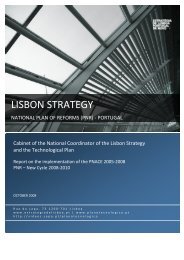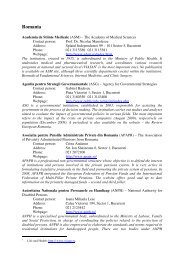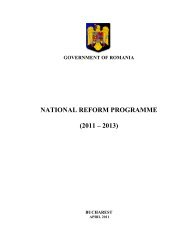National reform programme 2008-2010 Malta - European Commission
National reform programme 2008-2010 Malta - European Commission
National reform programme 2008-2010 Malta - European Commission
Create successful ePaper yourself
Turn your PDF publications into a flip-book with our unique Google optimized e-Paper software.
The improvement in the current account during the first quarter of <strong>2008</strong> is mainly attributable<br />
to the current transfers received as well as lower profits of foreign-owned companies<br />
repatriated abroad which compensated for the deterioration in the trade and services<br />
balances. In fact, the goods account was negatively affected by a fall in merchandise receipts<br />
as well as an increase in expenditure on merchandise imports. Increased receipts from<br />
tourists travelling to <strong>Malta</strong> contributed positively to the services account, however, such an<br />
effect was more than offset by increased expenditure of Maltese travellers going abroad.<br />
HICP inflation reached a low of 0.7% during 2007 marking a substantial decline from a level<br />
of 2.6% registered during the previous year. The rate of HICP inflation has, however, started<br />
to increase, partly reflecting the effect of international price pressures. In fact, the HICP<br />
inflation rate during the month of August in <strong>2008</strong> stood at 3.7%.<br />
The positive economic growth registered in recent years was reflected in a tightening of<br />
labour market conditions. The employment rate increased by 0.9 percentage points from<br />
54.8% in 2006 to 55.7 per cent during 2007. The employment rate stood at 54.7% in the first<br />
quarter of <strong>2008</strong>. There has been an increase in full time employment, while part-time<br />
employment has also continued to increase. While the employment rate has improved it<br />
remains significantly below the EU27 average which stood at 65.4% in 2007 and 65.5% for<br />
the first quarter of <strong>2008</strong>. The unemployment rate declined by 0.8 percentage points reaching<br />
6.5% in 2007. The rate of unemployment in <strong>Malta</strong> continued to decrease in the second<br />
quarter of <strong>2008</strong> reaching 6.0% thus continuing to remain below the EU27 average.<br />
With respect to international competitiveness, growth in nominal unit labour costs has been<br />
relatively contained since 2003, reaching levels close to zero during 2004 and 2005 before<br />
somewhat increasing again in 2006. The growth in nominal unit labour cost has, however,<br />
decreased again in 2007 and data for the first two quarters of <strong>2008</strong> shows a negative growth<br />
rate of 0.1%. Since 2003, the real unit labour cost growth rate for both <strong>Malta</strong> and the EU27<br />
was negative, with a relatively stronger average annual decline for <strong>Malta</strong> (-2.0%) compared to<br />
the EU27 (-0.9%)Such trends contribute positively towards the competitiveness of the<br />
domestic economy.<br />
The budgetary consolidation that commenced in 2004 has continued in 2007 with the general<br />
Government deficit declining further to 1.8% of GDP. The general Government debt-to-GDP<br />
ratio has also followed a downward trend, decreasing by 1.6 percentage points from 63.8% in<br />
2006 to 62.2 per cent in 2007.<br />
Macroeconomic Policy<br />
Issues and Opportunities<br />
Ensuring a stable and sound macroeconomic framework, which is conducive to price stability,<br />
is a necessary precondition to achieve sustainable economic growth and employment<br />
creation. In the run up to the adoption of the Euro, <strong>Malta</strong>’s macroeconomic environment has<br />
been strengthened. In particular, inflation has been relatively low whilst significant progress<br />
has been made in the consolidation of public finances. Participation in the Euro Area is<br />
conducive to further strengthen the macroeconomic framework. In particular, adoption of the<br />
euro has removed the exchange rate risk associated with the Maltese lira. Furthermore, it is<br />
widely acknowledged that the framework governing the euro makes it a stable currency with<br />
low inflation and low interest rates, and encourages sound public finances. Moreover, the<br />
adoption of a single currency increases price transparency, eliminates currency exchange<br />
costs, facilitates international trade and improves the integration of financial markets.<br />
The current international economic scenario presents downside risks to the growth outlook for<br />
the Maltese economy. These primarily relate to the financial turmoil, the slowing down of<br />
world economic growth, particularly in <strong>Malta</strong>’s main trading partners, inflationary pressures<br />
stemming from the relatively high international oil and commodity prices, as well as the<br />
appreciation of the Euro against the US dollar and the Pound sterling.<br />
<strong>Malta</strong> <strong>National</strong> Reform Programme <strong>2008</strong>-<strong>2010</strong> - 50 -







